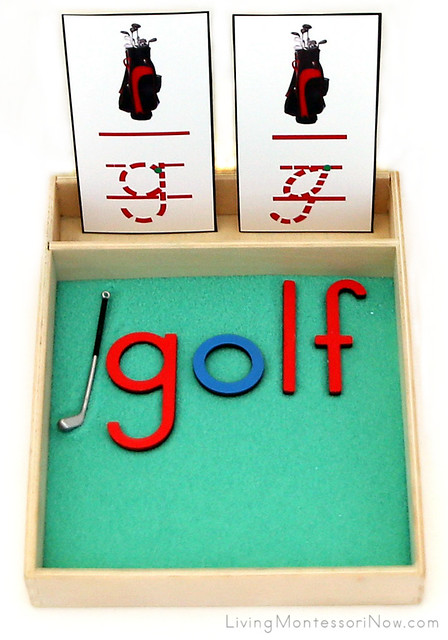Golf is a fun activity for children as young as preschoolers. Many towns and cities have inexpensive golf programs that are great for families. For summer, a golf unit is perfect ... especially around Father's Day if a special dad loves golf.
At Living Montessori Now, I have a list of free golf printables. The free printables include my latest subscriber freebie (a Montessori-inspired golf pack). Here, I'm sharing ideas for using free golf printables to create Montessori-inspired activities for preschoolers through first graders.
You'll find many activities for preschoolers through first graders throughout the year along with presentation ideas in my previous posts at PreK + K Sharing. You'll also find ideas for using free printables to create activity trays here: How to Use Printables to Create Montessori-Inspired Activities.
At Living Montessori Now, I have a post with resource links of Free Printables for Montessori Homeschools and Preschools.
Disclosure: This post contains some affiliate links (at no cost to you).
Montessori Shelves with Golf-Themed Activities
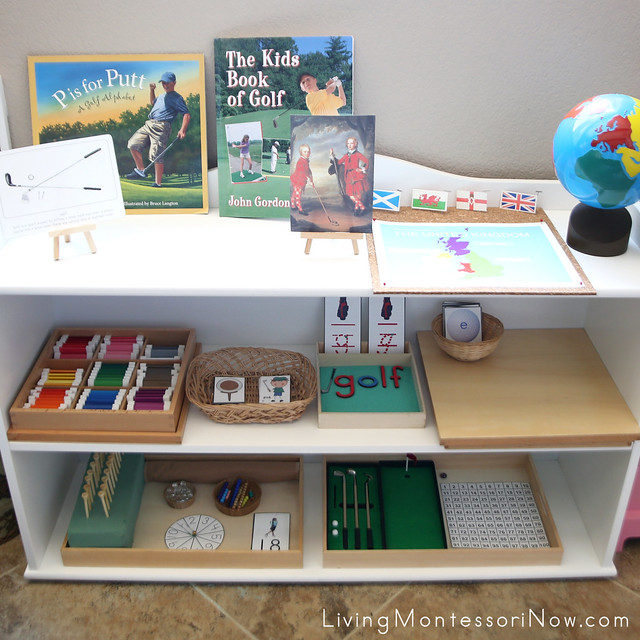
My shelves with golf-themed activities include a free golf culture card designed by The Montessori Company. You’ll also find Montessori-inspired golf numbers, letters, and and more (part of my subscriber freebie pack, so just sign up for my email to get the link and password … or check the bottom of your latest newsletter if you’re already a subscriber)
You could mix your golf-themed activities among your shelves according to curriculum area. Or you could have a special golf-themed area something like the one pictured. My shelves this month have a mixture of skill levels. Many of the activities can be adapted for a variety of levels.
If you’re a homeschooler, just choose the activities that work for your child’s interests and ability levels. If you don’t have room for all the activities you’d like to do, simply rotate them.
Golf Culture Card with P is for Putt Book
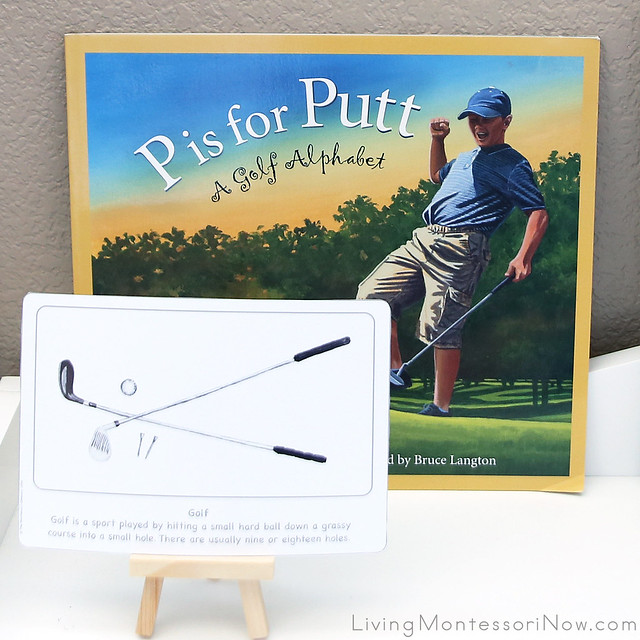
I love the alphabet series that includes P is for Putt: A Golf Alphabet by Brad Herzog. These books are written for a much wider age range than most alphabet books. There's a short verse related to the letter on each page that's perfect for even young preschoolers. Then there's much more information related to each letter's word for elementary-age kids.
I'm happy to share with you this golf culture card from The Montessori Company. I’m hosting the free printable as an instant download at Living Montessori Now. You can always access the free golf culture card here.
The description says: “Golf is a sport played by hitting a small hard ball down a grassy course into a small hole. There are usually nine or eighteen holes.”
Scotland and Golf Materials
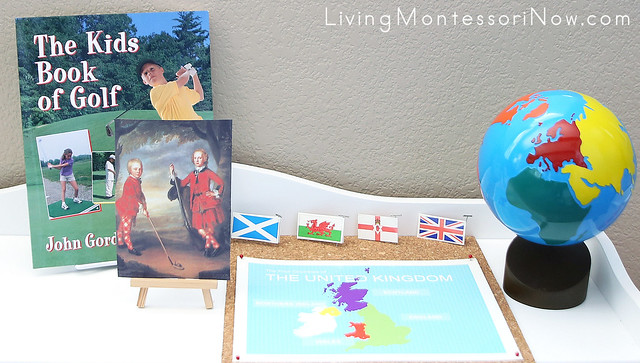
The origins of golf are unclear, but the modern day game is widely accepted to have originated in Scotland. The Kids Book of Golf has some information about Scotland's origins in Scotland.
Free Printable: 18th Century portrait of The MacDonald boys playing golf by Jeremiah Davison
Free Printable: Four Countries of the United Kingdom Template from Presentation Magazine
You can read more about Scotland and my Four Countries of the United Kingdom Pin Map here.
Free Printable Flags: You can get free flags for England, Scotland, and Wales from Wikipedia. I've seen both the England flag and the United Kingdom flag used as the flag of England. You'll have to decide which one you want to use.
The Northern Ireland flag is also available from Wikipedia. The official government flag of Northern Ireland is actually the Union Flag or Union Jack (the flag for the United Kingdom). But I used the unofficial flag, which is often used for sporting events, to represent Northern Ireland as a separate country. Size the flags in your printer as needed.
I included the Montessori continents globe for added geography work related to Scotland.
Book Basket
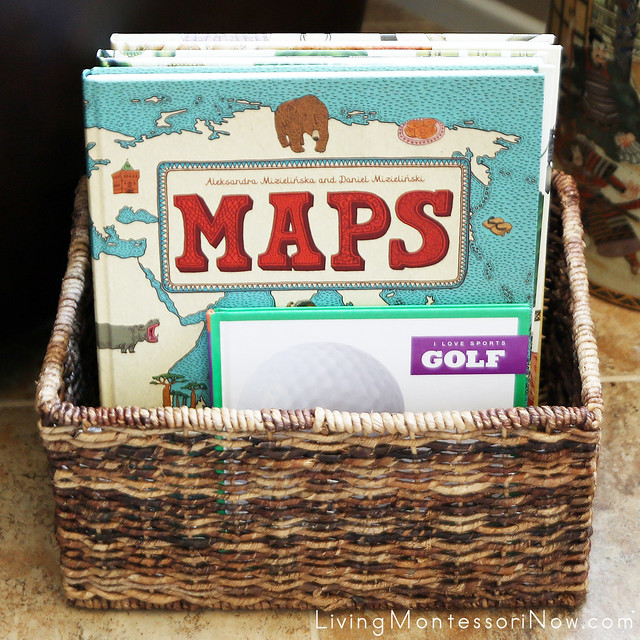
My 4½-year-old granddaughter, Zoey, loves the Maps book. We used it to discuss Scotland. Golf by Cari Meister is a Montessori-friendly beginning reader that uses photographs, introduces the rules of golf, and encourages kids to play golf.
In another book basket, we have Curious George Plays Mini Golf. It isn't a Montessori-style book, but it's a cute beginning reader for Curious George fans.
Golf Cursive G Work
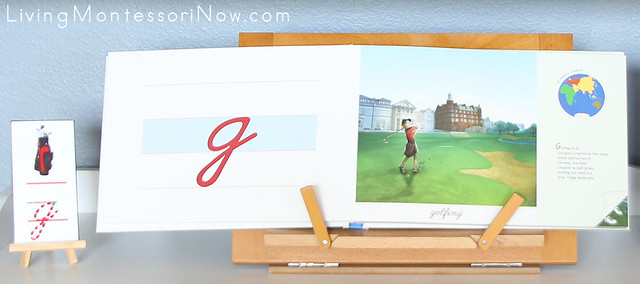
Free Printables: Golf Bag Letters for golf writing tray (part of my subscriber freebie pack, so just sign up for my email to get the link and password … or check the bottom of your latest newsletter if you’re already a subscriber)
On a different shelf from most of the golf activities, I have the cursive g font card along with the Montessori book Around the World from a to z. Zoey loves this book, and I love that it uses tactile cursive letters and sports themes around the world. Here I have it open to the g for golfing in Scotland pages.
Golf Color Matching for Montessori Color Box 2 or Color Box 3
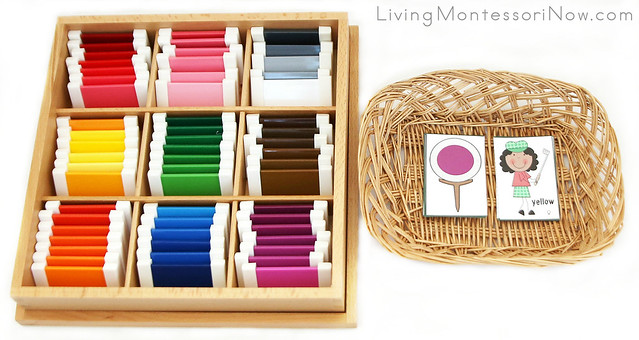
Free Printable: Tee-ing off with Colors 2-Part Cards by The Treasured Schoolhouse at Teachers Pay Teachers. I didn't use the tan cards from the set. I also used "gray" instead of "grey" and "purple" instead of "violet."
I used Color Box 3 for this work along with a Montessori Services basket. For homeschool use, I don't purchase Color Box 2 but use a DIY version of color tablets. (I use the free printable color matching cards from Montessori Services.) You could use a DIY version for Color Box 3 as well, which I've often done.
This can easily be used at more than one level. Younger children could simply match the card with the colored golf ball to the appropriate color tablet. For children working with color grading, you could have a setup like the one pictured. The child can choose the shade of color tablet that most closely matches each printed golf ball. Children who can read can match the color tablet, colored golf ball card, and card with the appropriate color name.
G is for Golf Salt Tray and Movable Alphabet Work
Free Printables: Golf Cart Letters for golf writing tray (part of my subscriber freebie pack, so just sign up for my email to get the link and password … or check the bottom of your latest newsletter if you’re already a subscriber)
For the salt tray, I used the wooden tray from the Melissa & Doug Lace and Trace Shapes. You can use whatever tray or container work best for you, though. I added the golf club from the Montessori Services language objects as an object of interest and as a unique writing tool. I also used letters from the small wooden movable alphabet to spell "golf."
For the movable alphabet work, I used a traditional small wooden movable alphabet and the golf movable alphabet. You could use Montessori Services language objects as words for spelling with the movable alphabet. For children working on their phonetic sounds, a variety of /g/ objects could be used in an object basket.
You could also use the golf movable alphabet for matching with the regular movable alphabet or sandpaper letters or having your child find the matching letter when you read a book such as P is for Putt.
If you would like help with introducing phonetic sounds, introducing objects with sounds, or beginning phonics in general, check out my DIY Beginning Montessori Phonics with Preschoolers.
Matching Teen Numerals with Golf Tees, Marbles, and Bead Bars (with Variation for Younger Children)
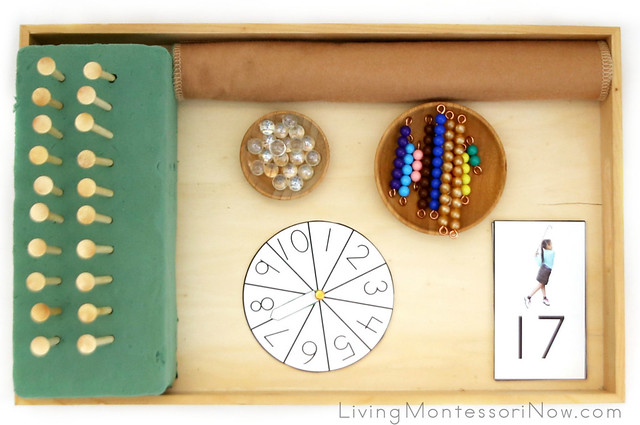 Free Printable: Golf Numbers (part of my subscriber freebie pack, so just sign up for my email to get the link and password … or check the bottom of your latest newsletter if you’re already a subscriber)
Free Printable: Golf Numbers (part of my subscriber freebie pack, so just sign up for my email to get the link and password … or check the bottom of your latest newsletter if you’re already a subscriber) This activity uses a piece of felt for a table mat (I used the Montessori Services felt table mat) and bead bars from the decanomial box in a Multicraft tray and a Bambu condiment cup (what I used here) or Montessori Services basket. (My bead bars, which I love, are from Alison’s Montessori. You can get bead bars on Amazon, although I haven’t personally used materials from those companies.)
I placed 20 golf tees in florist's foam. I also added 20 small clear marbles to represent golf balls.
 |
| Showing Her Work with 20 Golf Tees, Marbles, Beads, and Number Card |
For the activity, you could start with a column of 10 marbles on golf tees and then spin the spinner to find the units. (See my post on how to make a paperclip spinner that spins easily.)
This is a great activity for fine-motor coordination as well as working with teen numbers. The child then places the necessary number of marbles on the golf tees and finds the matching bead bars plus the matching number card.
For younger children, you could use a variation of this with the number cards 1-10, 10 marbles, and the 1-10 spinner.
Miniature Golf Putting Game with Hundred Chart
 Free Printable: Basic Counting Hundreds Chart from Math-Aids.com
Free Printable: Basic Counting Hundreds Chart from Math-Aids.com I used a Multicraft tray golf pen/club set with putting green, and small glass gem as the game piece.
This golf pen set could be a fun Father's Day gift, too! Zoey loved this set! Not only did she want to test out each of the golf clubs, but she had to draw with each of the pens.
This could be played with one person or as a cooperative game. I have the child hit the ball with the putter until it goes in the hole. Each time the ball goes in the hole, the game piece is moved along with hundred chart until 100 is reached.
Two or more children (or a child and adult) could take turns hitting the golf ball and moving the game piece. The game could take place over a number of days, too.
More Free Golf Printables
Go to my post at Living Montessori Now for links to free golf printables from around the blogosphere: Free Golf Printables and Montessori-Inspired Golf Activities. And be sure to subscribe to my email list if you'd like to get an exclusive free printable each month (plus two more awesome freebies right away): Free Printables.
More Golf Activities and Resources
-
- Montessori-Inspired Fun with Golf Balls and Ping Pong Balls
- Activities with Marbles and Golf Tees from Montessori at Home!
- Patriotic Golf Tee Practical Life and Math Activity
- Awesome DIY Water Table with Red, White, and Blue Activities
- Free Summer Playdough Math Pack (Montessori-Inspired Instant Download)
- Montessori-Inspired Playdough Math Activities for Summer {Free Printables}

Deb Chitwood is a certified Montessori teacher with a master’s degree in Early Childhood Studies from Sheffield Hallam University in Sheffield, England. Deb taught in Montessori schools in Iowa and Arizona before becoming owner/director/teacher of her own Montessori school in South Dakota. Later, she homeschooled her two children through high school. Deb is now a Montessori writer who lives in San Diego with her husband of 43 years (and lives in the city where her kids, kids-in-law, and grandkids live). She blogs at Living Montessori Now.



